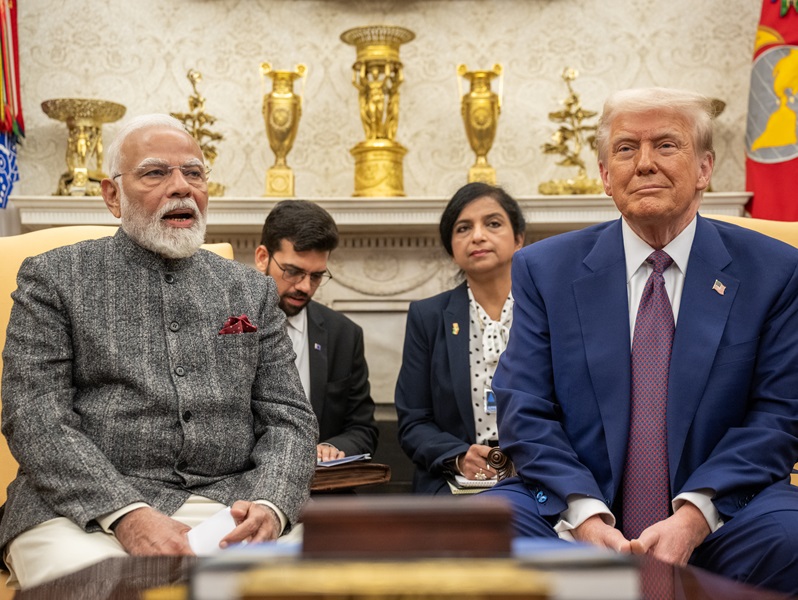.png)
SCO Summit: Beyond the Optics of Alignments
The Tianjin summit will offer many images of warmth between India, China and Russia, but the substance lies in India’s careful balancing of sovereignty and flexibility.

Dr. Srinath Sridharan is a Corporate Advisor & Independent Director on Corporate Boards. He is the author of ‘Family and Dhanda’.
September 1, 2025 at 7:56 AM IST
Nations in this ‘triumphant trio’ may ironically have US President Donald Trump to thank. By pushing his America First agenda so aggressively, and pushing others away, he has compelled Russia, China, and India to draw closer, for reasons of strategy, geopolitics, and global trade.
Each of the three nations carries its own economic vulnerabilities and sovereign ambitions, ensuring that collaboration in some arenas will coexist with competition in others. Interaction does not imply agreement, nor does dialogue guarantee common friends. As with any political alignment, choices will be shaped by circumstance and by the calculus of immediate advantage. For India, the lesson is clear: diplomacy cannot be dictated by headlines. It must be anchored in sovereignty — deciding with clarity which lines remain immutable, and which can adapt to the shifting terrain of global politics.
The revival of the Russia-India-China troika is not a novelty. It was first imagined in the late 1990s by Russian statesman Yevgeny Primakov, who saw it as a strategic counterweight to American dominance in the post-Cold War unipolar world. On paper, it promised clout. In practice, mistrust and competition repeatedly undercut cohesion.
The most obvious obstacle has always been the India-China border dispute. Stretching 3,488 km across the Himalayas, it has been a flashpoint for decades. The scars of the 1962 war, despite the time elapsed, remain raw, and in 2020 the Galwan Valley clashes delivered the extreme affront approach in decades. Diplomatic relations froze, visas were restricted, and trade in sensitive sectors was curtailed.
That is why the current optics of rapprochement are striking. At the Shanghai Cooperation Organisation summit in Tianjin, President Xi Jinping told Prime Minister Narendra Modi that China and India should be partners, not rivals. Modi, visiting China for the first time in seven years, spoke of a new “atmosphere of peace and stability” between the two nations. The language of deepening trust is notable, even if the scepticism persists. For India, sovereignty and security cannot be traded for symbolism. For China, rhetoric costs little.
Yet behind the atmospherics lies hard calculation. Moscow, hemmed in by sanctions and cut off from Western finance, will want to resurrect the RIC alignment as a shield against further isolation. Since 2014, Russia’s trade with China has surged past $200 billion, lubricated by yuan transactions and China’s financial rails such as UnionPay. Beijing is now Moscow’s ally, buyer and backer. In contrast, India’s economic leverage is anchored in access to US technology, capital and global supply chains - an advantage that cannot be substituted by Moscow or Beijing. This asymmetry will complicate the equation.
Even at the SCO summit, the media will inevitably be drawn to the optics — the handshakes, the postures, the carefully framed photographs. Yet the substance of diplomacy lies elsewhere, in the quiet backroom negotiations that rarely enter public debate. It is in these unglamorous exchanges that strategic outcomes are shaped, and it is precisely this invisible work that defines the responsibility of national leadership, both in politics and in policy.
The logic of a multipolar world — more accurately, a multipolar disorder — ensures that alignments will remain fluid, often temporary, and at times even contradictory. Nations will collaborate when interests align and contest one another when they do not. Interaction does not translate into consensus, nor does dialogue imply common loyalties. The RIC-idea, like all political configurations, will be shaped less by enduring commitments than by transactional choices dictated by circumstance.
Beneath this flux lies another constant: the weight of domestic politics. Every global leader carries the imperative of the next election as heavily as that of foreign policy. It is why one year a nation may pledge billions for climate finance, only for the next leader to dismiss climate change as a hoax. It is why appeals to peace are voiced even as conflicts deepen. The international stage is never insulated from the theatre of domestic compulsions.
India’s engagement with the SCO must be viewed through the continuum of its strategic autonomy. What began as non-alignment during the Cold War has matured into a doctrine of purposeful multi-alignment, a recognition that India’s interests are maximised by broadening choices rather than narrowing them.
This is not hedging born of caution but an assertion of agency, a deliberate choice to remain at the centre of overlapping alignments while guarding against compromise on sovereignty or core national interests. Participation in platforms such as the SCO underscores continuity of doctrine and clarity of execution: engagement without dilution of independence.
No other SCO member possesses the structural latitude India commands, the ability to stride two corridors of power simultaneously. The trans-Atlantic corridor provides access to capital, technology, and innovation ecosystems, while the Eurasian corridor delivers energy security, continental reach, and geopolitical depth. Russia’s alliance with China and China’s estrangement from the West render India’s dual positioning distinctive.
Through all of this, sovereignty remains the immovable line in India’s external relations. The past experiences are the reasons why no calculus of partnership or peace can override the primacy of territorial integrity. Even as atmospherics improve and leaders exchange language of trust, the fundamentals of statecraft will be defined by sovereignty.
For India, then, the task at Tianjin and beyond is not to be seduced by the imagery of trust, nor to be cornered by the compulsions of others. It is to balance sovereignty with flexibility, engage without illusion, and remember that strategic ambiguity is not weakness. It is statecraft.



